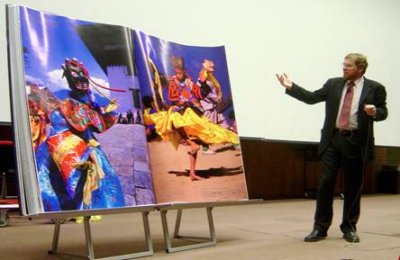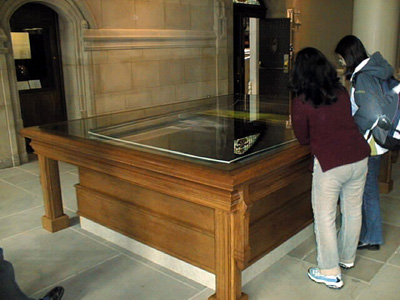A small part of the Book Arts Collections at the University of Washington…

Bhutan, a 2004 gift of an anonymous donor to the Libraries, joined the Book Arts Collection in the Special Collections Division. The Book Arts Collection is a group of 14,000 pieces, both historical and modern, of examples of book making of various forms. While it certainly held the record for size, there are many elements of Bhutan that fits it into a collection of equally stunning works. The lure of the book has long appealed to artists and size always has been a special challenge. Bhutan is reminiscent of the large antiphonaries of the medieval period, books of song meant to be sung from by a large group and big enough for everyone to see. There are huge 18th Century engravings by Giovanni Battista Piranesi so large they had to be folded to be bound into books. Similarly large atlases had maps folded when bound so that pages could be turned by a single reader and be part of a private library.
Bhutan tops a list of “big books”: John James Audubon’s Birds of America, David Roberts’ Egypt and Nubia, Thomas McKenney and James Hall’s History of the Indian tribes of North America-three 19th Century tour-de-force examples that pushed the technology of printing and binding, stand out in the history of book making because they were so uncommon. But, as with Bhutan, size was only part of their appeal. Both Audubon and Roberts were looking for way to capture the physical scale of their subjects. Audubon and McKenney and Hall featured rich hand colored illustrations. These books documented time and place and people, holding on to treasures in the changing world. Audubon has images of birds now extinct-Roberts gives us views of the Middle East worn away by sand and war-McKenney and Hall provide a vision of the American Native in his glory in the 1830’s. Hopefully Bhutan the country will hold on to the beauty of its natural environment and cultural richness so that Bhutan will not be the repository for the bones of a society over run by golden arches and the magic kingdom.
Everything about Bhutan is extraordinary: it is printed with a gallon of ink on a roll of paper longer than a football field. The printing process takes an entire 24 hours for each copy. It weighs 133 pounds making it the heaviest book in Special Collections as well as the biggest. The technical challenges of printing and binding a book of this size and weight are as enormous as the book. As much care went into displaying the book as into creating it. The Libraries commissioned a custom designed exhibition case so that Bhutan could be safely put on display in Suzzallo Library in a way that will not endanger the heavy binding. The case was made on campus, designed by Ed McKinley and fabricated by Carmine Ruggiero. Danette Rogers did the case finishing work.
